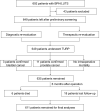Incidence and Risk Factors of Post-Operative Depression in Patients Undergoing Transurethral Resection of Prostate for Benign Prostatic Hyperplasia
- PMID: 34785940
- PMCID: PMC8590608
- DOI: 10.2147/IJGM.S329817
Incidence and Risk Factors of Post-Operative Depression in Patients Undergoing Transurethral Resection of Prostate for Benign Prostatic Hyperplasia
Abstract
Background: Benign prostatic hyperplasia (BPH) is a frequent-occurring disease in middle-aged and elderly men. This work is a prospective study and aims at exploring the incidence of post-operative depression and the potential risk factors of depression in a cohort of patients with BPH in China.
Methods: In this survey, 611 men who underwent transurethral resection of the prostate (TURP) were strictly selected at our institution from January 2016 to August 2019. Zung Self-rating Depression Scale was used for evaluation of depressive symptoms. Sociodemographic, clinical and other data were also collected.
Results: We found that 152/611 (24.9%) patients suffered from different degree of depression at 6 months after TURP, including mild symptoms (20.9%) and moderate/severe symptoms (3.9%). A total of 421 (68.9%) patients developed post-TURP erectile dysfunction (ED). The occurrence of depression was closely associated with marital status, education level, cigarette smoking, alcohol consumption, severity of lower urinary tract symptoms (LUTS), duration of BPH, erectile function, and comorbidities (such as diabetes, dyslipidaemia and bladder stone). The risk factors related to the severity of depression included widowed or single marital status, frequent alcohol consumption, moderate or severe LUTS, longer duration (> 5 years) of BPH, ED, urinary continence, and comorbidities such as diabetes and bladder stone.
Conclusion: Many risk factors are related to the occurrence of depression in patients undergoing TURP. Widowed or single marital status, frequent alcohol consumption, moderate or severe LUTS, longer duration of BPH, ED, urinary incontinence and comorbidities such as diabetes and bladder stone are connected with the increase odds of moderate or severe depressive symptom.
Keywords: BPH; TURP; benign prostate hyperplasia; depression; prevalence rate; risk factors; transurethral resection of the prostate.
© 2021 Zhu et al.
Conflict of interest statement
The authors declared no conflicts of interest.
Figures
Comment in
-
Geriatrics.J Urol. 2022 Jun;207(6):1325-1327. doi: 10.1097/JU.0000000000002659. Epub 2022 Mar 23. J Urol. 2022. PMID: 35319258 No abstract available.
References
-
- Thomas AW, Cannon A, Bartlett E, Ellis-Jones J, Abrams P. The natural history of lower urinary tract dysfunction in men: the influence of detrusor underactivity on the outcome after transurethral resection of the prostate with a minimum 10-year urodynamic follow-up. BJU Int. 2004;93(6):745–750. doi:10.1111/j.1464-410X.2003.04719.x - DOI - PubMed
LinkOut - more resources
Full Text Sources


